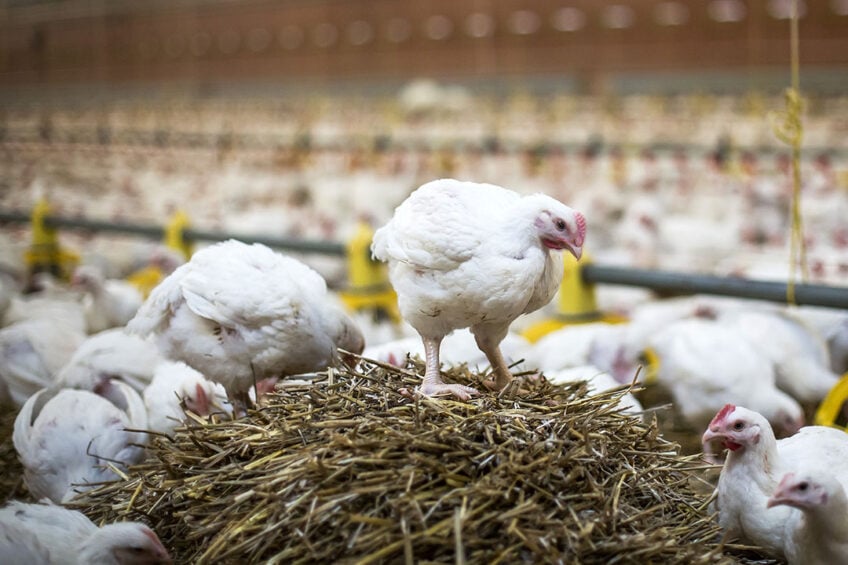November 25, 2025 | 17:49 GMT +7
November 25, 2025 | 17:49 GMT +7
Hotline: 0913.378.918
November 25, 2025 | 17:49 GMT +7
Hotline: 0913.378.918

James Bentley, Hubbard technical director, says that breed choice and efficiency were critical for reducing the global warming potential for slower-growing birds. Photo: Diederik van der Lane
Based on calculations for a typical European broiler feed ration, 85% of the feed footprint is due to feed ingredients, with the remaining 15% stemming from processing and transport.
Speaking at the recent Hubbard Premium Forum in Evian, France, James Bentley, Hubbard technical director, told delegates that breed choice and efficiency were critical for reducing the global warming potential for slower-growing birds. “Feed is the major factor we can manipulate,” he stressed.
Possible mitigations included:
Dr Bentley said maintaining appropriate protein levels in rations was essential, especially around the amino acid percentages in the feed versus conventional broilers. For example, using lower protein diets for the Dutch Beter Leven 1*, adapted to the breed requirement, helps to reduce the impact of LUC ingredients like non-certified soya, using alternatives and certified soya.
While field beans have shown progress as an alternative protein source to soya, results have been mixed and major poultry operations need consistent inputs to maintain efficiency. There is also a large problem with supply chains for rapeseed, sunflower and legumes, meaning that some of the soya alternatives are not agronomically attractive to producers.
Other technologies like insects, PAP, algal protein, grass protein and yeast by-products are on the horizon but are not immediate solutions in Europe. There was a need to assess each product’s CO2 status versus certified soya, but there was also a long-term incentive to use them for their impact in regenerative/circular agriculture.
Turning to nutrient density, Dr Bentley said the least-cost feed is high in energy, which means high in protein, and further needs a high soya percentage. The challenge ahead is to use lower nutrient density diets and avoid the need to use “nutrient dense” high protein ingredients like soya, with a high LUC, for Better Chicken Commitment broilers. Using more local ingredients and cereals as a percentage of total protein could be a way forward.
One company that is producing a low carbon footprint for its chickens is Norwegian-based Norsk Kylling. Results of the lifecycle analysis completed in 2021 showed that the carbon footprint for raw chicken products produced by the company was 4.1 CO2 equivalent per kg – a lower carbon footprint than Norwegian-farmed Atlantic salmon.
Switching from faster-growing Ross birds to slower-growing Hubbard broilers led to a 1% decline in the carbon footprint. There was also lower feed consumption in rearing and layer farm production, reduced mortality, and reduced transport needs.
In summary, Dr Bentley highlighted the following feed GWP mitigations:
(PW)

(VAN) Brazil's COP30 presidency pushed through a compromise climate deal on Saturday that would boost finance for poor nations coping with global warming but that omitted any mention of the fossil fuels driving it.

(VAN) Poultry farmers in the UK have been warned that they could face one of the worst winters yet for bird flu.

(VAN) Prices of main-crop paddy have risen sharply, with jasmine rice hitting 16,100 baht per tonne — the highest level in years.

(VAN) In Brazil, FAO unveiled a series of reports and initiatives showing how sustainable agrifood systems are a solution to the climate crisis.

(VAN) With names like neodymium and dysprosium, rare-earth elements sound exotic — and their perceived scarcity has only added to the mystique.

(VAN) In a new study published in Trends in Biotechnology, researchers used a gene-editing technology called CRISPR to increase a fungus's production efficiency and cut its production-related environmental impact by as much as 61%- all without adding any foreign DNA.

(VAN) A top official in Beijing’s Cop delegation says China is committed to clean energy – but US’s absence is a problem.